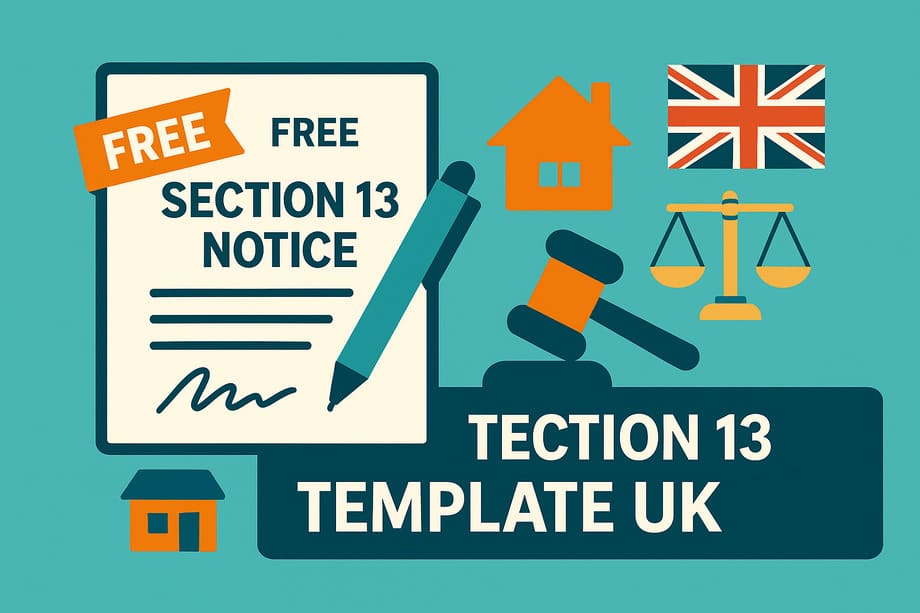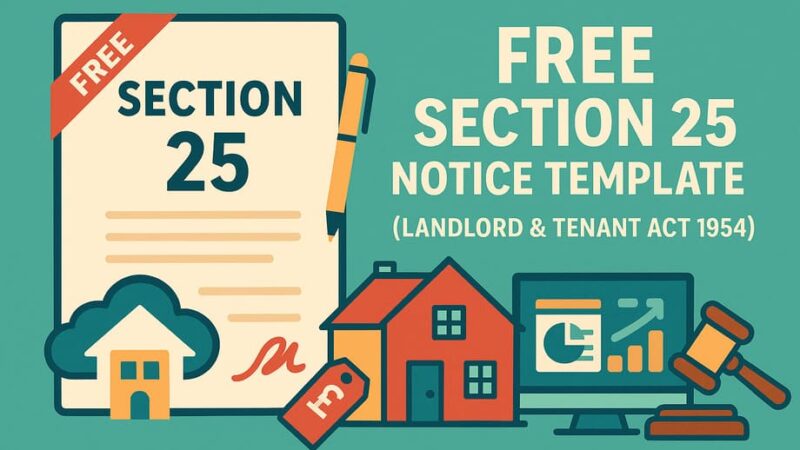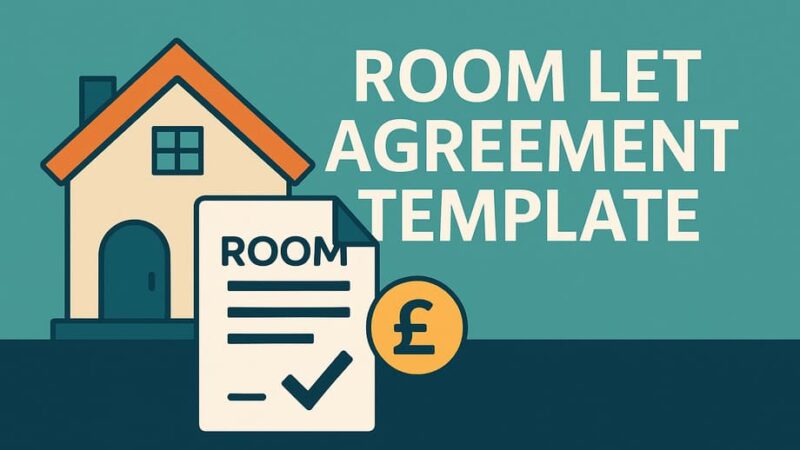Free Section 13 Notice Template UK (Word & PDF Download)

Need to increase rent on your periodic tenancy? A Section 13 notice is the legal way for landlords to raise rent under an Assured Shorthold Tenancy (AST) after the fixed term ends. Our free Section 13 notice template ensures you follow the correct legal procedures and avoid costly mistakes that could invalidate your rent increase.
Download our compliant Section 13 template in Word and PDF formats, complete with step-by-step guidance to help you serve notice properly and protect your rental income.
What Is a Section 13 Notice in the UK?
A Section 13 notice is a formal legal document that allows landlords to increase rent on assured shorthold tenancies that have become periodic (rolling month-to-month or week-to-week). It’s governed by Section 13 of the Housing Act 1988 and provides a statutory method for rent increases without requiring tenant agreement.
Key features of Section 13 notices:
- Only applies to periodic tenancies (not fixed-term)
- Allows rent increases to fair market rates
- Must use official Form 4 from the government
- Cannot be used more than once every 12 months
- Tenants can challenge unreasonable increases through tribunal
This notice is essential when your fixed-term tenancy expires and becomes a statutory periodic tenancy, giving you the legal right to adjust rent to current market levels.
When Can a Landlord Use a Section 13 Notice?
Understanding when you can legally serve a Section 13 notice prevents invalid attempts and wasted time:
After Fixed-Term Expires
- Only use when tenancy has become periodic
- Cannot serve during any fixed-term period
- Wait until rolling monthly/weekly tenancy established
- Applies to statutory and contractual periodic tenancies
Once Every 12 Months Maximum
- Minimum 12-month gap between Section 13 increases
- Measured from effective date of last increase
- Other rent increase methods don’t reset this timeline
- No exceptions to the annual limitation
Minimum Notice Requirements
- Monthly tenancies: At least 1 month’s notice
- Weekly tenancies: At least 1 month’s notice
- Quarterly tenancies: At least 3 months’ notice
- Yearly tenancies: At least 6 months’ notice
Fair Market Rate Only
- Increase must reflect reasonable local rents
- Cannot be excessive or punitive
- Research comparable properties before setting amount
- Tenants can challenge unreasonable increases
Key Information to Include in a Section 13 Notice
Your Section 13 notice must contain specific information to be legally valid:
Essential Details Required
Tenant Information:
- Full names of all tenants exactly as in tenancy agreement
- Complete property address including postcode
- Current contact details for correspondence
Rent Details:
- Current rent amount and payment frequency
- Proposed new rent amount and frequency
- Clear calculation showing increase amount
- Effective date for new rent (properly calculated)
Landlord Information:
- Your full name and contact address
- Phone number and email for queries
- Agent details if using property management
- Signature and date of notice
Legal Compliance Elements
Form 4 Requirements:
- Must use official government Form 4
- Include all prescribed information
- Provide proper notice periods
- Explain tenant rights clearly
Market Justification:
- Evidence of comparable local rents
- Property improvements or market changes
- Fair assessment based on current conditions
- Reasonable increase reflecting market rates
Free Section 13 Notice Template (Word & PDF)
Download our professionally prepared Section 13 notice template that includes all legal requirements:
Legally compliant Form 4 format
All prescribed information included
Step-by-step completion guide
Common mistakes checklist
Service instructions included
[DOWNLOAD WORD TEMPLATE] | [DOWNLOAD PDF TEMPLATE]
Our template includes:
- Official Form 4 layout and wording
- Clear instructions for each section
- Tenant rights information
- Landlord declaration section
- Guidance notes for proper completion
Available formats:
- Word Document: Editable for multiple properties
- PDF Version: Print and complete by hand
- Completion Guide: Step-by-step instructions
How to Serve a Section 13 Notice Properly
Correct service is crucial for a valid Section 13 notice:
Must Use Form 4 (Official Government Format)
- Download latest version from GOV.UK
- Use prescribed wording exactly
- Include all required sections
- Don’t modify or abbreviate content
- Complete every field accurately
Acceptable Service Methods
Personal Service (Best Evidence):
- Hand deliver directly to all named tenants
- Get signed acknowledgment if possible
- Use witness if tenant refuses to sign
- Most reliable proof for any disputes
Postal Service:
- Send by recorded delivery to property address
- Allow extra time for delivery when calculating notice
- Keep postal receipts as proof of service
- Address to all tenants listed in agreement
Email Service (Limited):
- Only if tenancy agreement specifically permits
- Get delivery receipt confirmation
- Follow up with hard copy by post
- Less reliable evidence for court proceedings
Keep Proof of Service
Always Document:
- Method of service used
- Date and time notice delivered
- Photos of posting through letterbox
- Witness statements for hand delivery
- Any acknowledgment from tenants
Common Mistakes Landlords Make With Section 13 Notices
Avoid these costly errors that invalidate notices:
Trying to Increase Rent During Fixed Term
- Section 13 only works for periodic tenancies
- Cannot use during any fixed-term period
- Use contractual rent review clauses instead
- Wait until tenancy becomes periodic
Not Using the Correct Form
- Must use official Form 4 from government
- Cannot create your own version
- Include all prescribed information
- Use current version with latest updates
Giving Less Than Required Notice
- Calculate notice periods accurately
- Count from day after service
- Allow extra time for postal delivery
- Ensure effective date aligns with rent periods
Setting Unfair or Above-Market Increases
- Research comparable local properties
- Keep increases reasonable and justified
- Document market evidence for tribunal
- Avoid excessive or punitive amounts
Poor Service and Documentation
- No proof of service retained
- Wrong service method used
- Insufficient notice period allowed
- Missing tenant names or addresses
FAQ
How much notice does a landlord have to give under Section 13?
Landlords must give at least 1 month’s notice for most periodic tenancies. For quarterly tenancies, 3 months notice is required, and yearly tenancies need 6 months notice. The notice period starts the day after the tenant receives the Section 13 notice.
Can a tenant refuse a Section 13 rent increase?
Tenants cannot directly refuse a Section 13 rent increase, but they can challenge it by applying to the First-tier Tribunal within 6 weeks of receiving the notice. The tribunal will assess whether the proposed rent reflects fair market rates and may confirm, reduce, or occasionally increase the rent amount.
Do I have to use the official Section 13 Form 4?
Yes, landlords must use the official Form 4 available from GOV.UK. This prescribed form includes all legally required information and specific wording. Creating your own version or modifying the official form can invalidate the notice and delay your rent increase.
Can I serve a Section 13 during the fixed term?
No, Section 13 notices can only be served on periodic tenancies, not during fixed-term periods. You must wait until the fixed term expires and the tenancy becomes periodic (rolling month-to-month). During fixed terms, use contractual rent review clauses if included in your tenancy agreement.
How often can I use Section 13 to increase rent?
You can only serve a Section 13 notice once every 12 months. This limitation applies regardless of other rent increase methods you may have used. The 12-month period is calculated from the effective date of the last Section 13 increase, not from when the notice was served.
What happens if I make a mistake on the Section 13 notice?
Mistakes on Section 13 notices can invalidate them entirely. Common errors include wrong tenant names, insufficient notice periods, or serving during fixed terms. If your notice is invalid, you’ll need to start the process again with a corrected notice, potentially delaying your rent increase by months.
Can tenants challenge my Section 13 rent increase?
Yes, tenants have 6 weeks from receiving the notice to apply to the First-tier Tribunal if they believe the rent increase is unreasonable. The tribunal will consider market evidence and set a fair rent amount. Tenants continue paying the current rent during tribunal proceedings.
What evidence should I gather for a Section 13 rent increase?
Research comparable rental properties in your area, noting similar sizes, conditions, and locations. Document any property improvements you’ve made and gather evidence from rental websites, estate agents, and local property listings. This evidence helps justify your increase and defends against tribunal challenges.
Conclusion
A Section 13 notice is essential for legally increasing rent on periodic tenancies, providing landlords with a statutory method to adjust rents to current market levels. Using our free Section 13 template ensures you meet all legal requirements and avoid common mistakes that could invalidate your notice.
Remember to serve your notice properly, allow adequate notice periods, and keep thorough documentation throughout the process. With proper preparation and our compliant template, you can increase rent confidently while protecting your investment.
Ready to increase your rental income legally? Download your free Section 13 Notice template now and follow our step-by-step guide to serve a valid rent increase notice.
[DOWNLOAD FREE SECTION 13 TEMPLATE (WORD & PDF)]
Last Updated on September 16, 2025 by James Cartwright






![Letter to Tenant for Late Rent Payment [Free Template] 6 Letter to Tenant for Late Rent Payment [Free Template]](https://www.yourpropertyblog.co.uk/wp-content/uploads/2025/08/letter-to-tenant-for-late-rent-payment-template-800x450.jpg)
![Letter to Landlord About Damp and Mould [Free Template] 7 Letter to Landlord About Damp and Mould [Free Template]](https://www.yourpropertyblog.co.uk/wp-content/uploads/2025/08/letter-to-landlord-about-damp-and-mould-template-800x450.jpg)